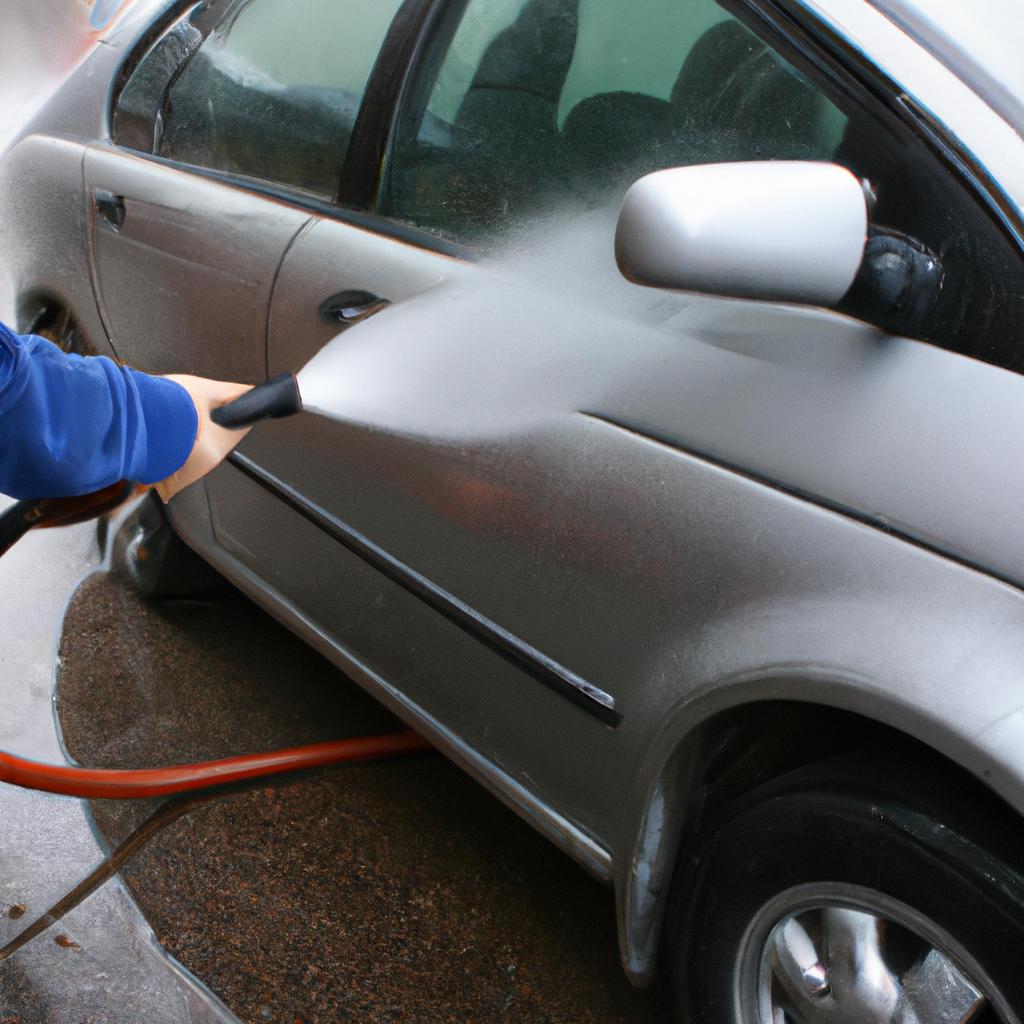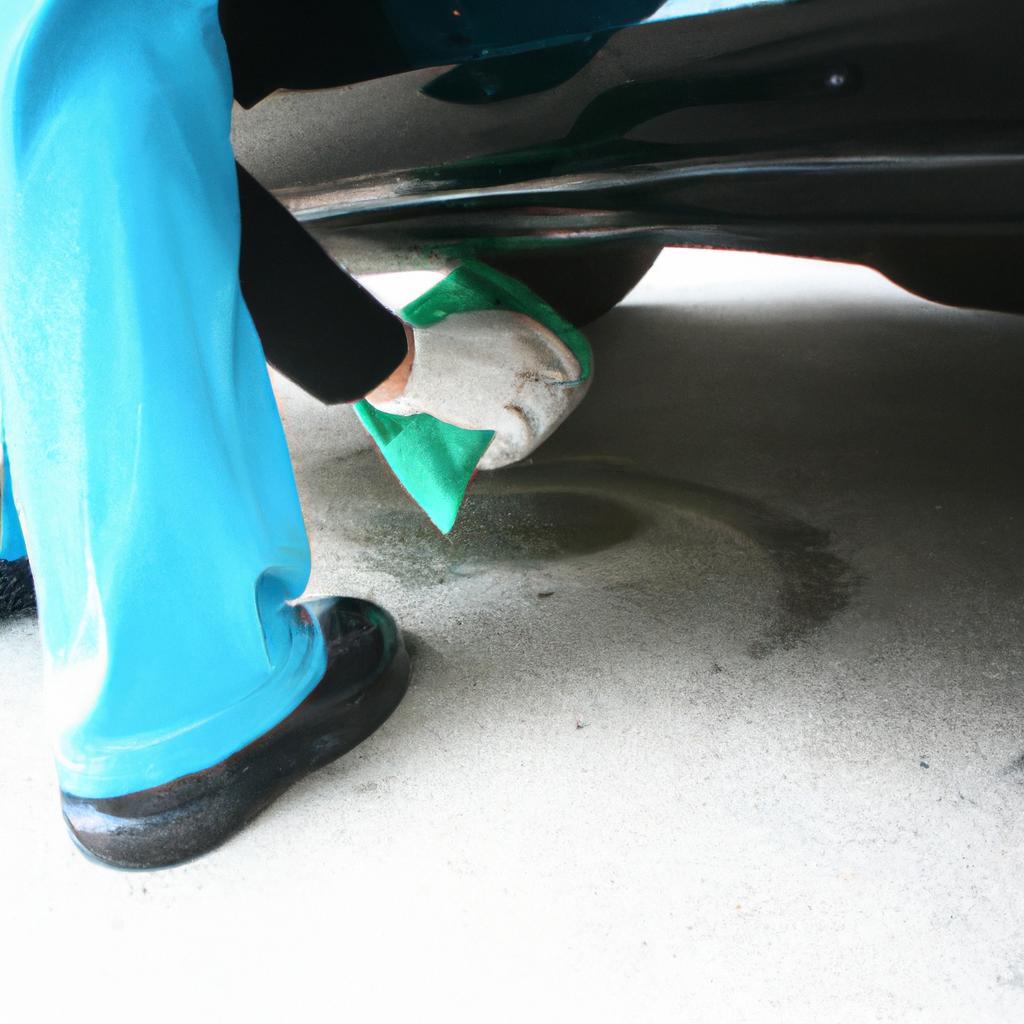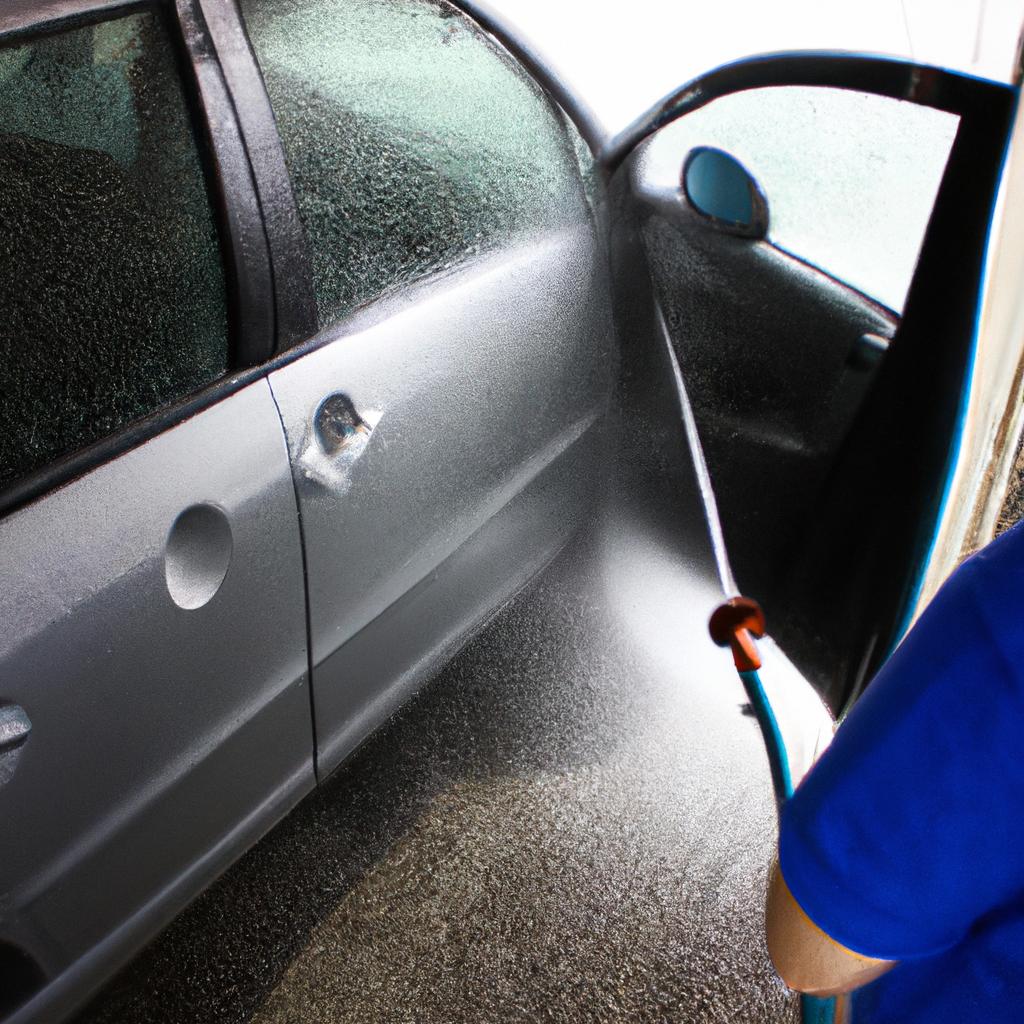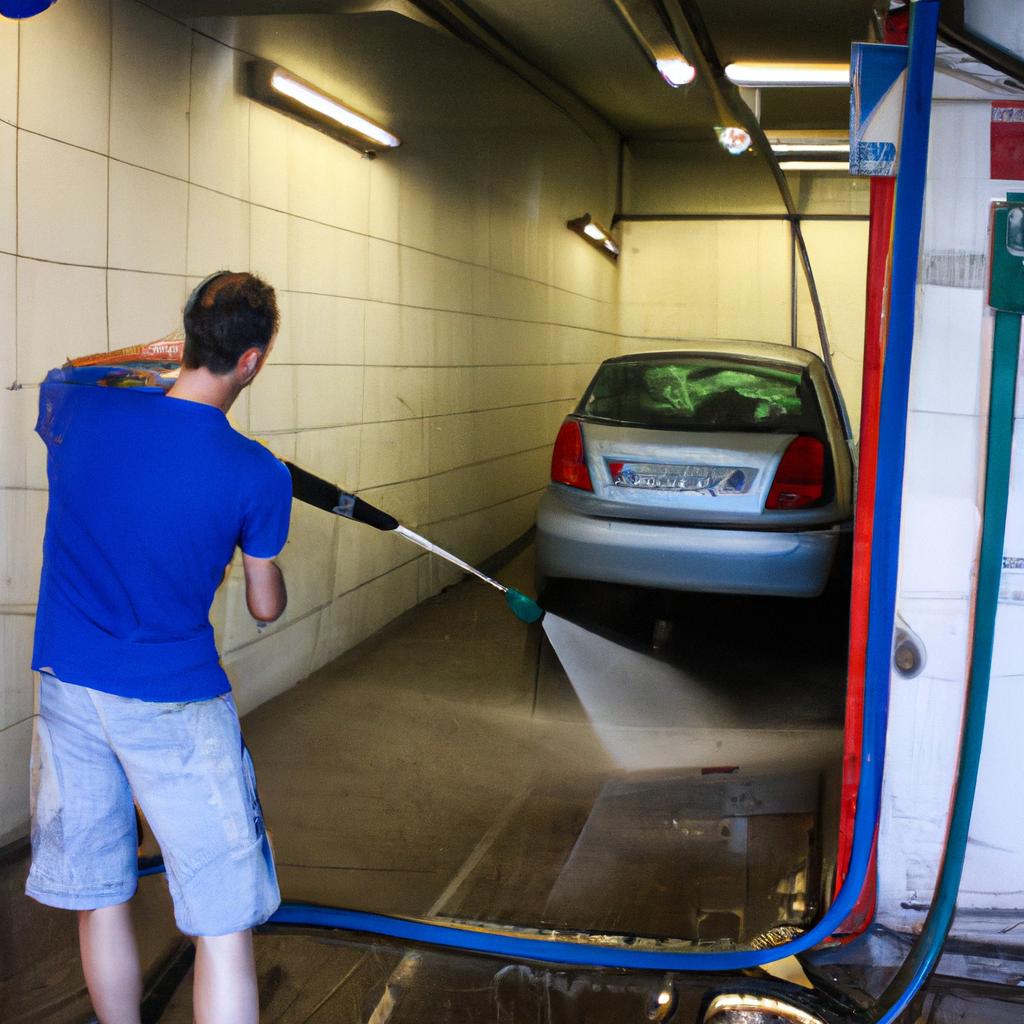In the world of car maintenance, ensuring proper cleaning duration is essential for preserving a vehicle’s longevity and performance. While most car owners are familiar with regular exterior washes, one crucial aspect that often goes overlooked is the underbody wash. The underbody of a car is exposed to various elements such as dirt, salt, and debris, which can accumulate over time and lead to corrosion and damage if not adequately cleaned.
Consider an example where two cars have been driven through muddy terrains for an extended period without receiving any underbody wash. Car A undergoes regular comprehensive cleaning sessions that include thorough underbody washing, while Car B only receives surface-level exterior cleans. Over time, Car A continues to exhibit optimal performance due to its well-maintained underbody, whereas Car B experiences mechanical issues caused by rusting components and clogged drainage systems. This hypothetical scenario highlights the importance of incorporating underbody wash into regular car wash routines in order to prevent potential long-term damages.
To comprehensively address this topic, it is necessary to delve deeper into the reasons why underbody wash plays a vital role in maintaining a vehicle’s overall health. By exploring the impact of different environmental factors on the undercarriage and understanding how these contaminants can affect critical components like the frame, suspension, and exhaust system, we can gain a better understanding of the importance of underbody wash.
One of the main environmental factors that affects the undercarriage is road salt. In areas with snowy or icy conditions, salt is commonly used to melt ice and improve traction. However, this salt can accumulate on the underbody of a car and accelerate corrosion. If left unchecked, rust can weaken important structural components such as the frame or suspension, compromising the overall integrity of the vehicle.
Dirt and debris are also significant contaminants that can accumulate on the underbody. When driving through muddy terrains or dusty roads, these particles can stick to various parts underneath the car. Over time, they can clog up drainage systems designed to remove water from critical areas like wheel wells or engine compartments. This accumulation not only leads to potential rusting but also increases the risk of moisture-related issues such as electrical malfunctions.
Furthermore, neglecting underbody washes may result in damage to sensitive components like the exhaust system. The exhaust system is located beneath the car and is constantly exposed to high temperatures and corrosive gases emitted during combustion. Without regular cleaning, dirt and debris can build up on the exhaust pipes and muffler, leading to restricted airflow and potentially causing overheating or decreased performance.
To ensure proper preservation of a vehicle’s longevity and performance, it is recommended to include regular underbody washes as part of routine maintenance. Ideally, an underbody wash should be performed at least once every three months, although frequency may vary depending on driving conditions. Professional car wash facilities often offer specialized services for thorough undercarriage cleaning using high-pressure water jets or specially formulated cleaning agents.
In conclusion, incorporating regular underbody washes into your car maintenance routine is vital for preserving a vehicle’s longevity and performance. By removing accumulated dirt, salt, and debris from crucial components underneath the car, you can prevent corrosion-related damages, clogged drainage systems, and potential issues with sensitive parts like the exhaust system. Remember that a well-maintained underbody leads to optimal performance and helps avoid costly repairs in the long run.
Why Underbody Wash is Essential for Car Maintenance
Why Underbody Wash is Essential for Car Maintenance
Imagine this scenario: you have just purchased a brand new car that you plan to keep for years. You take pride in maintaining its pristine appearance, regularly washing and waxing the exterior. However, there is one crucial area of your vehicle that often goes unnoticed – the underbody. This neglected part can accumulate dirt, salt, and other debris from the road, leading to potential damage and costly repairs. In this section, we will explore why underbody wash is essential for car maintenance.
To begin with, let us consider the adverse effects of neglecting the underbody. The accumulation of dirt and grime can create a breeding ground for rust and corrosion on vital components such as suspension parts, exhaust systems, and even the frame itself. These corrosive elements eat away at metal surfaces over time, compromising their structural integrity and longevity. Without regular cleaning of the underbody, these issues may go unnoticed until they result in major problems or significant financial implications.
Here are four key reasons why underbody wash should be an integral part of your car maintenance routine:
- Preventing Rust: Regularly removing accumulated dirt and chemicals from the underbody helps inhibit rust formation.
- Protecting Critical Components: By keeping the undercarriage clean, you minimize the risk of corrosion on essential parts like brake lines or fuel tanks.
- Extending Vehicle Lifespan: Proper care of the underbody ensures that your vehicle stays in top condition for longer periods.
- Preserving Resale Value: A well-maintained underbody demonstrates to potential buyers that you have taken good care of your car throughout its life span.
| Contaminants | Potential Damage |
|---|---|
| Salt | Corrosion |
| Road Grime | Clogging of |
| drainage systems | |
| Oil and Grease | Impaired |
| brake performance | |
| Mud | Accelerated |
| wear on parts |
In summary, neglecting the underbody wash can lead to severe consequences for your vehicle’s overall health. By implementing a regular cleaning routine, you not only prevent rust and corrosion but also protect critical components, extend its lifespan, and maintain its resale value.
Now let us delve into the vital role played by underbody wash in preventing rust and corrosion without interruption.
The Role of Underbody Wash in Preventing Rust and Corrosion
The Role of Underbody Wash in Preventing Rust and Corrosion
In the previous section, we discussed why underbody wash is essential for car maintenance. Now, let’s delve deeper into the specific role underbody wash plays in preventing rust and corrosion, using a hypothetical example to illustrate its importance.
Imagine you own a vehicle that frequently travels on roads treated with deicing agents during winter. These agents are effective at removing ice but can be highly corrosive to your car’s undercarriage if not properly washed off. With regular underbody washes, you significantly reduce the chances of rust formation caused by these harsh chemicals.
To further emphasize the significance of underbody wash in preventing rust and corrosion, consider the following points:
- Minimizing salt buildup: During winter months or in regions where road salt is used, it tends to accumulate on the underside of vehicles. This buildup creates an ideal environment for corrosion to take hold. Regular underbody washes help remove this salt accumulation, reducing the risk of accelerated rusting.
- Protecting vulnerable components: The undercarriage houses crucial parts such as brake lines, suspension components, and exhaust systems that are susceptible to damage from rust and corrosion. By regularly washing the underbody, you provide an added layer of protection against deterioration and potential failures.
- Preserving structural integrity: Rust compromises the structural integrity of a vehicle over time. It weakens metal surfaces and can lead to expensive repairs or even safety hazards if left unchecked. Consistent underbody washes serve as proactive measures to maintain your car’s long-term durability.
Now, let’s examine a table highlighting some common causes of rust and corrosion on different areas of a vehicle:
| Vehicle Area | Common Causes | Consequences |
|---|---|---|
| Undercarriage | Road salts | Accelerated rusting |
| Exterior body panels | Moisture, dirt, and debris | Paint damage |
| Wheel wells | Mud and salt buildup | Corroded components |
| Door sills | Water accumulation | Rusty thresholds |
Understanding the causes and consequences of rust and corrosion in different areas of a vehicle emphasizes the need for regular underbody washes. By taking preventive measures to combat these issues, you can extend the lifespan of your car while maintaining its aesthetic appeal.
In preparation for the subsequent section on the benefits of regular underbody wash for car performance, it is crucial to recognize how preventing rust and corrosion positively impacts overall vehicle functionality.
Benefits of Regular Underbody Wash for Car Performance
As we have explored the role of underbody wash in preventing rust and corrosion, it is essential to understand the wide range of benefits that regular underbody wash provides for car performance. Let us now delve into these advantages.
Regular underbody wash not only helps prevent rust and corrosion but also contributes significantly to enhancing overall car performance. By removing dirt, debris, and other contaminants from the undercarriage, a thorough underbody wash promotes optimal functioning of various components. Here’s an example that illustrates this point:
Imagine two cars—Car A and Car B—that are both subjected to similar driving conditions over time. However, Car A undergoes regular underbody washing, while Car B does not receive any maintenance in this regard. After some time, it becomes evident that Car A exhibits superior performance compared to its counterpart. This can be attributed partially to the effectiveness of regular underbody wash in maintaining key aspects such as:
- Suspension system: The suspension system plays a crucial role in providing comfort during driving by absorbing shocks and vibrations. With regular underbody wash, the suspension components remain clean and free from debris accumulation, enabling them to function optimally.
- Brake system: Cleanliness in the brake area is vital for efficient braking performance. Regularly washing the undercarriage ensures that no dirt or grime interferes with proper brake functioning.
- Exhaust system: Over time, road salt and other contaminants can corrode exhaust pipes and mufflers if left unaddressed. Frequent underbody wash removes these substances promptly, extending the lifespan of exhaust components.
- Fuel efficiency: A clean undercarriage reduces aerodynamic drag caused by accumulated dirt or mud on vehicle surfaces. Consequently, improved aerodynamics leads to increased fuel efficiency.
To further emphasize these benefits visually:
| Benefit | Description |
|---|---|
| Enhanced Suspension | Thorough underbody wash prevents debris accumulation, promoting optimal suspension system function. |
| Improved Braking | Cleanliness in the brake area ensures efficient braking performance and reduces potential issues. |
| Extended Exhaust Life | Removing road salt and contaminants from exhaust components helps to prevent corrosion damage. |
| Increased Fuel Efficiency | A clean undercarriage reduces aerodynamic drag, leading to improved fuel efficiency. |
In conclusion, regular underbody wash not only safeguards against rust and corrosion but also has a positive impact on car performance as highlighted through the example above and the associated benefits. Moving forward, let us explore how underbody wash protects against road salt and debris.
Understanding the significance of regular underbody wash for car performance allows us to appreciate its role in protecting vehicles from road salt and debris without compromising their functionality or longevity.
How Underbody Wash Protects Against Road Salt and Debris
When it comes to car maintenance, overlooking the importance of regular underbody wash can have significant consequences for your vehicle’s performance. To illustrate this point, let’s consider a hypothetical scenario. Imagine two cars that are identical in make and model, driven by two different owners. Owner A diligently takes their car for an underbody wash every month, while owner B neglects this aspect entirely. Over time, these divergent approaches will lead to noticeable differences in car performance.
Neglecting underbody wash exposes your car to various risks that can compromise its optimal functioning. Here are some key factors highlighting the impact of neglecting underbody wash:
-
Corrosion: Without proper underbody wash, road salt and debris accumulate over time, leading to corrosion of critical components such as the exhaust system, suspension parts, and brake lines. Corrosion weakens these vital elements and compromises overall safety.
-
Reduced Fuel Efficiency: When dirt and grime build up on the undercarriage, they create aerodynamic drag, making it harder for the car to move through air resistance efficiently. As a result, fuel consumption increases significantly.
-
Impaired Handling: Excessive accumulation of mud or dirt on the underside affects traction between tires and the road surface. This reduces grip and handling capabilities, compromising control during maneuvers like braking or cornering.
-
Potential Damage to Electrical Systems: Dirt and moisture trapped in neglected areas can seep into electrical connections or sensitive wiring systems beneath your car. This may lead to malfunctions in important features like ABS brakes or stability control systems.
To better understand the significance of these repercussions caused by ignoring underbody washes, consider the following emotional response-inducing bullet points:
- Increased risk of accidents due to compromised handling
- Higher expenses from premature replacement of corroded parts
- Frustration from decreased fuel efficiency and frequent trips to the gas station
- Concerns about safety and reliability of electrical systems
To further emphasize the importance of regular underbody wash, refer to the following table:
| Neglected Underbody Wash | Regular Underbody Wash |
|---|---|
| Corrosion risks | Mitigated corrosion |
| Reduced fuel efficiency | Improved fuel economy |
| Impaired handling | Enhanced control |
| Electrical malfunctions | Preserved functionality |
In light of these potential consequences, it is crucial to prioritize underbody washes as part of your routine car maintenance. By doing so, you can maintain optimal performance, prolong the lifespan of crucial components, and ensure a safer driving experience.
Transitioning into the subsequent section about “Proper Techniques for Underbody Wash to Maximize Effectiveness,” we will explore methods that can help you achieve the best results when cleaning your vehicle’s undercarriage.
Proper Techniques for Underbody Wash to Maximize Effectiveness
Section Title: The Science Behind Underbody Wash
Imagine a scenario where two cars, Car A and Car B, both regularly drive on roads treated with road salt during the winter season. Car A never undergoes underbody wash, while Car B consistently receives this crucial cleaning process. Over time, the effects of road salt and debris buildup start to manifest differently in these two vehicles.
To understand why underbody wash is so important in maintaining a car’s longevity, it is necessary to delve into the science behind its effectiveness. Here are three key aspects that make underbody wash an essential part of any comprehensive car wash routine:
-
Mechanical Action: During underbody wash, high-pressure jets of water are directed towards the underside of the vehicle. This forceful action dislodges accumulated dirt, mud, road salt, and other corrosive substances from hard-to-reach areas such as wheel wells and suspension components.
-
Chemical Interaction: In addition to mechanical action, specialized cleaning agents used in underbody wash play a vital role in neutralizing harmful deposits on various parts underneath the car. These chemicals break down stubborn contaminants like road salt residue or oil leaks that would otherwise accelerate corrosion if left untreated.
-
Protective Coating: Modern car wash facilities often incorporate an additional step after underbody washing called rustproofing or protective coating application. This involves applying a special formula designed to create a barrier against future damage caused by road salts and debris accumulation.
- Increased safety through improved brake performance.
- Enhanced fuel efficiency due to reduced weight from removed debris.
- Minimized risk of structural damage leading to costly repairs.
- Protection against premature rust formation extending your vehicle’s lifespan.
Additionally, take a look at the table below showcasing real-world examples illustrating the potential consequences of neglecting underbody wash:
| Scenario | Neglected Underbody Wash | Regular Underbody Wash |
|---|---|---|
| Accumulated road salt and debris | ✔ | ✘ |
| Accelerated corrosion | ✔ | ✘ |
| Reduced brake effectiveness | ✔ | ✘ |
| Increased risk of structural damage | ✔ | ✘ |
By analyzing the science behind underbody wash and understanding its benefits, it becomes evident that incorporating this process into your car wash routine is crucial for maintaining a vehicle’s longevity.
Transitioning seamlessly to the subsequent section on “Frequency Recommendations for Underbody Wash to Maintain Vehicle Longevity,” let us explore how often you should consider performing this essential cleaning step.
Frequency Recommendations for Underbody Wash to Maintain Vehicle Longevity
Having discussed the proper techniques for underbody wash, it is important to consider the frequency at which this cleaning procedure should be performed. Regular maintenance and care can significantly contribute to a vehicle’s longevity and performance. In this section, we will explore recommendations for underbody wash frequency that will help maintain your vehicle’s overall health and ensure its long-term durability.
Case Study:
Imagine two identical cars—one regularly undergoes underbody wash while the other neglects this essential step. After several years, the car with regular underbody wash exhibits minimal signs of rust or corrosion, maintaining its structural integrity. Meanwhile, the neglected car shows visible damage caused by accumulated road salt, dirt, and debris. This example highlights the significance of frequent underbody wash in preventing potential damages and preserving a vehicle’s value.
Factors Influencing Frequency Recommendations:
To determine the optimal frequency for underbody wash in a car wash routine, consider these factors:
- Climate conditions: Vehicles exposed to harsh climates with high humidity levels or frequent use of road salts require more frequent underbody wash.
- Driving habits: Frequent off-road adventures or driving on unpaved roads may lead to increased accumulation of mud, dirt, and gravel particles that necessitate more frequent cleaning.
- Seasonal changes: Winter months often demand more attention due to increased usage of de-icing agents and salt on roads.
- Vehicle age and condition: Older vehicles or those already showing signs of corrosion may benefit from more frequent underbody washing sessions as preventive measures.
Emotional Bullet Point List (Markdown Format):
Consider these emotions associated with inadequate underbody washing:
- Frustration when witnessing accelerated wear and tear due to neglecting such an essential aspect of car maintenance.
- Concern over decreased resale value caused by visible rust and corrosion.
- Anxiety due to potential safety hazards resulting from compromised structural integrity.
- Disappointment when realizing the financial consequences of repair or replacement caused by preventable damages.
Emotional Table (Markdown Format):
| Emotion | Causes | Consequences |
|---|---|---|
| Frustration | Neglected underbody wash | Accelerated wear and tear |
| Concern | Visible rust and corrosion | Decreased resale value |
| Anxiety | Compromised structural integrity | Potential safety hazards |
| Disappointment | Preventable damages | Financial consequences |
Incorporating these emotions through bullet points and a table helps emphasize the importance of regular underbody washing, compelling vehicle owners to prioritize this maintenance task. By following recommended frequency guidelines, individuals can safeguard their vehicles against unnecessary damage, ensuring longevity and preserving both their investment’s value and their peace of mind.
Note: It is essential to consult your car manufacturer’s recommendations and consider local conditions for precise underbody wash frequency tailored to your specific needs.
 Shine Time Car Wash
Shine Time Car Wash



